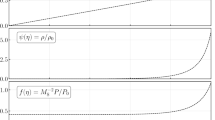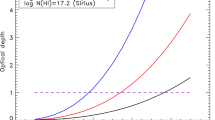Abstract
We describe here as to how the Doppler shift of a source needs to be used to measure its velocity and acceleration. We also apply this method, as an example here, to spectral lines of the blue-shifted jet in micro-quasar SS433 and discuss the intricacies of these measurements.



Similar content being viewed by others
References
Ashby N. 2003, Relativity in the Global Positioning System, Living Rev. Relativity, 6, 1 [online article: http://www.livingreviews.org/lrr-2003-1].
Fabrika S. 2004, Astrophysics and Space Physics Reviews, 12, 1.
French A. P. 1966, Special Relativity (The MIT Introductory Physics Series), W W Norton & Co., New York.
Ives H. E. and Stilwell G. R. 1938, J. Opt. Soc. Am., 28, 215–236.
Margon B. 1984, ARA&A, 22, 507.
Margon B. and Anderson S. F. 1989, ApJ, 347, 448.
Marshall H. L., Canizares C. R., Hillwig T., Mioduszewski A., Rupen M., Schulz N. S., Nowak M., and Heinz S. 2013, Multi-wavelength Observations of the SS433 Jets (to be published in ApJ) (arxiv.org/astro-ph.HE/1307.8427).
Mirabel I. F. 1999, ARA&A, 37, 409.
Wagh S. M. 2013a, Pramana – J. Phys., 81 (3), 439–448 (doi:10.1007/s12043-013-0584-6).
Wagh S. M. 2013b, J. Modern Physics, 4 (8A), 102–104 (doi:10.4236/jmp.2013.48A008).
Wagh S. M. 2013c, Subtlety in relativity, Paper for SPIE Conference on The Nature of Light. What are photons? V – Part of Optics and Photonics Event, paper no. 8832-25, San Diego, California, 25–29 August 2013.
Wagh S. M. and Sarwe S. B. 2013, Jets in micro-quasar SS433: Analysis involving acceleration, J. Astrophys. Aerospace Tech., to be published.
Acknowledgements
The author would like to thank the anonymous referee for raising the issues of the Appendix and for other useful as well as helpful suggestions.
Author information
Authors and Affiliations
Corresponding author
Appendix
Appendix
The ‘usual’ Doppler shift formula is (see, for example, French 1966):
This formula has also received experimental validation, for example, in many cosmic ray experiments involving relativistically moving charged particles emitting radiation. We recall the derivation of this formula that is based on the following diagram:
Figure A1(a) shows a stationary source emitting ‘first’ pulse at time t 1 and the ‘second’ pulse at time t 2, the time measured in the frame of the source. The frequency of emission is then 1/(t 2−t 1). The ‘initial’ line-of-sight (SO), is shown making an angle \(\bar {\theta }\) with the Y-axis. When the first pulse reaches the observer at O, time elapsed is T 1=t 1+(SO)/c.
Let the observer move along the line OP making an angle \(\bar {\phi }\) with the X-axis, with P being the point at which the second pulse reaches the observer at time T 2=t 2+(SP)/c. Then,
With \((\text {SO})=\sqrt {{x_{1}^{2}}+{y_{1}^{2}}}\), \((\text {SP})^{2}=\sqrt { (x_{1}+\delta x)^{2}+(y_{1}+\delta y)^{2}}\), x 1>>δ x, y 1>>δ y, we get
But, \(\delta x = (\text {OP})\cos {\bar {\phi }}\) and \(\delta y = (\text {OP})\sin {\bar {\phi }}\); and we get to first order
where 𝜃 is the angle line OP makes with line SO.
If we consider the observer to be stationary and source to be moving, considerations similar to those of the above applied to of Fig. A1(b) then yield to first order:
We distinguish the time measured by the observer with an overhead prime.
Notice that we are not required to specify how the observer has moved along line OP or the source has moved along the line SP, that is to say, with uniform velocity or with acceleration. Equations (A4) and (A5) hold generally.
Now, as described on page 142 in French (1966), we can approximate
for u as ‘uniform’ velocity. On using equation (A6) in equation (A5), we then obtain
where we have used β=u/c and that \({\Delta } t^{\prime } = 1/\nu _{e}\sqrt {1-\beta ^{2}}\) with ν e being the frequency of the emitted wave in the rest frame of the source. This is the standard formula of equation (A1) or equation (5)–(17) on page 143 of French (1966).
But, eq. (A6) has an error. Distance (SP) is ‘not’ \(u{\Delta } t^{\prime }\), but \((\text {SP})=u{\Delta } T^{\prime }\). The source, if at all it does so, moves only during the period \({\Delta } T^{\prime }=T_{2}^{\prime }-T_{1}^{\prime }\), and not during Δt=t 2−t 1.
Then, using the ‘correct’ expression \((\text {SP})=u{\Delta } T^{\prime }\), we obtain
However, it is easy to see that this ‘correct’ special relativistic formula contradicts the results of the Ives–Stilwell experiment.
On calculations for 𝜃=0 and 𝜃=π, we obtain for the first- and second-order wavelength shifts:
Equation (A9) provides the parabolic relation between the first order and second order wavelength shifts, but with ‘three times’ the coefficient as implied by equation (A1). Equation (A9) is therefore ruled out by the Ives–Stilwell experiment (Ives & Stilwell 1938).
Now, the above method of deriving the Doppler shift can be seen to be related to that described in section 1. For this purpose, consider Fig. A2 providing the details needed as in Fig. 1(a).
Referring to Fig. A2, we have \((\text {MP})\ge (\mathrm {M}^{\prime }\mathrm {P}) = (\text {MQ}) \ge (\text {MP}^{\prime })\). Then, the derivation of equation (A1) as shown above uses the part \((\text {MQ})\approx (\text {MP}^{\prime })\), while the method in Section 1 of obtaining the Doppler shift uses the part \((\text {MP})\approx \sqrt {(\text {MP}^{\prime })^{2}+(\text {OP})^{2}\sin ^{2}{\theta }} \) of the above inequality relation. Then, \((\text {MP}^{\prime })\) underestimates (MQ), the actual distance travelled by light during time ΔT, and (MP) overestimates it.
Replacing \((\text {OP})\sin {\theta }\) by \((\text {OP})\sin {\theta }-(\mathrm {P}^{\prime }\mathrm {P}^{\prime \prime })\), with \(\mathrm {P}^{\prime }\mathrm {P}^{\prime \prime }=(\text {SM}^{\prime })\sin {\phi }\sim (\text {SO})\sin {\phi }\), we convert the formula of the first method to that of the second method. Then experiments will not distinguish between the two methods.
Now, we notice that equation (5) reduces to 1±β, the non-special relativistic expressions of the Doppler shift, for 𝜃=0,π. On the other hand, the standard formula, equation (A1), reduces to \(\sqrt {\frac {1-\beta }{1+\beta }}\) for 𝜃=0 and to \(\sqrt {\frac {1+\beta }{1-\beta }}\) for 𝜃=π. Equation (5) will not correspond with equation (A1), which is validated by a variety of experiments (Ashby 2003).
Therefore, we have the situation that the standard formula, equation (A1) is well-supported by experiments, but is theoretically inappropriate. Theoretically correct special relativistic formula of equation (A9) gets ruled out by the Ives–Stilwell experiment. However, it is still unclear as to why equation (A1) correspond well with the experimental results.
On the other hand, equation (5) is obtained for the case of constant acceleration, and it disagrees with the standard formula and, hence, with experiments. Further investigations are thus essential for an appropriate resolution of this situation.
We may nevertheless use variable acceleration to express distance (SP) in equation (A5) in terms of appropriate quantities, or as described in section 4, to gain further understanding of the ways of measuring velocity and acceleration of the source from its Doppler shift. This is described in the main body of this paper.
Rights and permissions
About this article
Cite this article
Wagh, S.M. Measuring Velocity and Acceleration Using Doppler Shift of a Source with an Example of Jet in SS433. J Astrophys Astron 35, 595–605 (2014). https://doi.org/10.1007/s12036-014-9304-y
Received:
Accepted:
Published:
Issue Date:
DOI: https://doi.org/10.1007/s12036-014-9304-y






